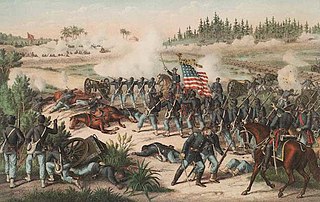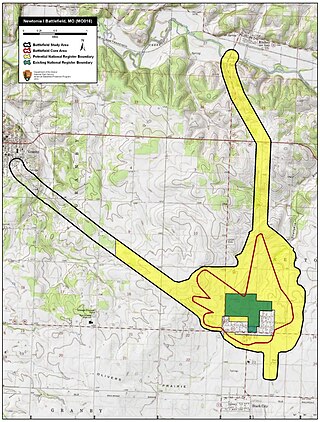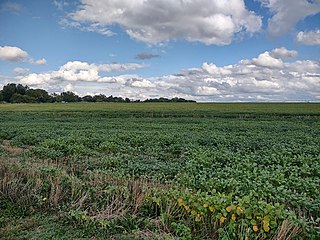
Mount Jackson is a town in Shenandoah County, Virginia, United States. The population was 1,994 at the 2010 census.

The Battle of Atlanta took place during the Atlanta Campaign of the American Civil War on July 22, 1864, just southeast of Atlanta, Georgia. Continuing their summer campaign to seize the important rail and supply hub of Atlanta, Union forces commanded by William Tecumseh Sherman overwhelmed and defeated Confederate forces defending the city under John Bell Hood. Union Major General James B. McPherson was killed during the battle, the second-highest-ranking Union officer killed in action during the war. Despite the implication of finality in its name, the battle occurred midway through the Atlanta campaign, and the city did not fall until September 2, 1864, after a Union siege and various attempts to seize railroads and supply lines leading to Atlanta. After taking the city, Sherman's troops headed south-southeastward toward Milledgeville, the state capital, and on to Savannah with the March to the Sea.

The Battle of Olustee or Battle of Ocean Pond was fought in Baker County, Florida on February 20, 1864, during the American Civil War. It was the largest battle fought in Florida during the war.

The Battle of Richmond, Kentucky, fought August 29–30, 1862, was one of the most complete Confederate victories in the war by Major General Edmund Kirby Smith against Union major general William "Bull" Nelson's forces, which were defending the town. It was the first major battle in the Kentucky Campaign. The battle took place on and around what is now the grounds of the Blue Grass Army Depot, outside Richmond, Kentucky.

Kennesaw Battlefield Park preserves a Civil War battleground of the Atlanta Campaign, and also contains Kennesaw Mountain. It is located at 900 Kennesaw Mountain Drive, between Marietta and Kennesaw, Georgia. The name "Kennesaw" derives from the Cherokee Indian "Gah-nee-sah" meaning "cemetery" or burial ground. The area was designated as a U.S. historic district on October 15, 1966.

Fort Pillow State Historic Park is a state park in western Tennessee that preserves the American Civil War site of the Battle of Fort Pillow. The 1,642 acre (6.6 km²) Fort Pillow, located in Lauderdale County on the Chickasaw Bluffs overlooking the Mississippi River, is rich in both historic and archaeological significance. In 1861, the Confederate army built extensive fortifications and named the site for General Gideon Johnson Pillow of Maury County. It was attacked and held by the Union Army for most of the American Civil War period except immediately after the Battle of Fort Pillow, when it was retaken by the Confederate Army. The battle ended with a massacre of African-American Union troops and their white officers attempting to surrender, by soldiers under the command of Confederate Major General Nathan Bedford Forrest.
The Battle of Cool Spring, also known as Castleman's Ferry, Island Ford, Parker's Ford, and Snicker's Ferry, was a battle in the American Civil War fought July 17–18, 1864, in Clarke County, Virginia, as part of the Valley Campaigns of 1864. The battle was a Confederate victory.
The Battle of Fort Davidson, also known as the Battle of Pilot Knob, was a battle of Price's Missouri Expedition fought on September 27, 1864, near Pilot Knob, Missouri. Confederate troops under the command of Major-General Sterling Price had entered Missouri in September 1864 with hopes of challenging Union control of the state. On September 24, Price learned that Union troops held Pilot Knob. Two days later, he sent part of his command north to disrupt and then moved towards Pilot Knob with the rest of his army. The Confederate divisions of Major-General James Fagan and Brigadier-General John Marmaduke drove Union troops under Brigadier-General Thomas Ewing and Major James Wilson from the lower Arcadia Valley into Fort Davidson on September 26 and on the morning of September 27.

The First Battle of Newtonia was fought on September 30, 1862, between Confederate soldiers commanded by Colonel Douglas H. Cooper and a Union column commanded by Brigadier General Frederick Salomon near Newtonia, Missouri, during the American Civil War. Cooper's force had moved into southwestern Missouri, and encamped near the town of Newtonia. The Confederate column was composed mostly of cavalry led by Colonel Joseph O. Shelby and a brigade of Native Americans. A Union force commanded by Brigadier General James G. Blunt moved to intercept Cooper's force. Blunt's advance force, led by Salomon, reached the vicinity of Newtonia on September 29, and attacked Cooper's position on September 30. A Union probing force commanded by Colonel Edward Lynde was driven out of Newtonia by Cooper's forces on the morning of the 30th.

The Battle of Champion Hill of May 16, 1863, was the pivotal battle in the Vicksburg Campaign of the American Civil War (1861–1865). Union Army commander Major General Ulysses S. Grant and the Army of the Tennessee pursued the retreating Confederate States Army under Lieutenant General John C. Pemberton and defeated it twenty miles to the east of Vicksburg, Mississippi, leading inevitably to the Siege of Vicksburg and surrender. The battle is also known as Baker's Creek.

Lexington Cemetery is a private, non-profit 170-acre (69 ha) rural cemetery and arboretum located at 833 W. Main Street, Lexington, Kentucky.

The Richmond National Battlefield Park commemorates 13 American Civil War sites around Richmond, Virginia, which served as the capital of the Confederate States of America for most of the war. The park connects certain features within the city with defensive fortifications and battle sites around it.
The Camden Expedition was the final campaign conducted by the Union Army in south Arkansas during the Civil War. The offensive was designed to cooperate with Major-General Nathaniel P. Banks' movement against Shreveport.

The Camden Expedition Sites is a national historic landmark consisting of nine nationally significant historic places in southwest Arkansas where events of the Union army's disastrous Camden Expedition of 1864 occurred during the American Civil War. The Union was attempting to take over Shreveport, Louisiana. Each of the sites are individually listed on the National Register of Historic Places. It was designated a national historic landmark on April 19, 1994.

The Prairie D'Ane Battlefield, also known as Prairie D'Ann Battlefield or Prairie De Ann Battlefield in anglicized forms, was the site of the Civil War Battle of Prairie D'Ane, one of the engagements in southwestern Arkansas of the Union's Camden Expedition of 1864. It was listed on the National Register of Historic Places in 1974, and, with other sites, is part of the Camden Expedition Sites National Historic Landmark. It was declared part of the National Historic Landmark in 1994.
The Mine Creek Battlefield State Historic Site, located 2.5 miles (4.0 km) southwest of Pleasanton in eastern Kansas, United States, commemorates the Battle of Mine Creek in the American Civil War. On October 25, 1864, approximately 2,800 Union troops attacked and defeated about 8,000 Confederates along the banks of Mine Creek. It was one of the largest cavalry battles in the Civil War, and the only major battle fought in Kansas. The Union brigades were commanded by Colonels Frederick W. Benteen and John Finis Philips. After this battle, Federal forces pursued and defeated additional Confederates in Missouri as they attempted to return to Arkansas, the Indian Territory (Oklahoma), and Texas.

Fort Davidson, a fortification near the town of Pilot Knob, Missouri, was the site of the Battle of Fort Davidson during the American Civil War. Built by Union Army soldiers during the American Civil War, the fort repulsed Confederate attacks during the Battle of Fort Davidson on September 27, 1864, during Price's Raid. That night, the Union garrison blew up the fort's magazine and abandoned the site. A mass grave was constructed on the site to bury battlefield dead. After the war, the area was used by a mining company, before passing into private hands and eventually the administration of the United States Forest Service. In 1968, the Battle of Pilot Knob State Historic Site was created as a Missouri State Park. The fort itself was added to the National Register of Historic Places in 1970. As of 2020, a visitors center containing a museum is located within the park. The museum contains a fiber optic display, as well as artifacts including Brigadier General Thomas Ewing Jr.'s sword. The fort's walls are still visible, as is the crater created when the magazine was detonated. A monument marks the location of the mass grave.

Pickett's Mill Battlefield Site is a Georgia state park in Paulding County, Georgia, that preserves the American Civil War battlefield of the Battle of Pickett's Mill. The 765-acre site includes roads used by Union and Confederate troops, earthwork battlements, and an 1800s-era pioneer cabin. The area's ravine is a site where hundreds died. The park's visitor center includes exhibits and a film about the battle.

The First Battle of Newtonia Historic District, near Newtonia, Missouri, is a National Register of Historic Places (NRHP) site that preserves the location of the First Battle of Newtonia, an 1862 battle during the American Civil War. The battle saw Confederate troops under Colonels Douglas H. Cooper and Joseph O. Shelby defeat a Union force commanded by Brigadier General Frederick Salomon. The historic district contains some Civil War-period structures, as well as the Mathew H. Ritchey House, which is listed separately on the NRHP.

The Second Battle of Newtonia Site is a battlefield listed on the National Register of Historic Places (NRHP) near Newtonia and Stark City in Missouri. In late 1864, Major General Sterling Price of the Confederate States Army began a raid into Missouri in hopes of diverting Union troops away from more important theaters of the American Civil War. After a defeat at the Battle of Westport on October 23, Price's Army of Missouri began retreating through Kansas, but suffered three consecutive defeats on October 25. By October 28, the retreating Confederates had reached Newtonia, where the Second Battle of Newtonia broke out when Union pursuers caught up with the Confederates. Confederate cavalry under Brigadier General Joseph O. Shelby was initially successful, but after Union reinforcements under Brigadier General John B. Sanborn counterattacked, the Confederates withdrew. The Union troops did not pursue, and Price's men escaped, eventually reaching Texas by December.

















